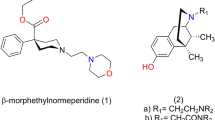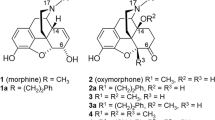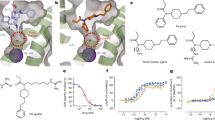Abstract
The μ and δ opiate receptors, postulated on the basis of pharmacological observations, have been well characterized in ligand-binding studies1–6. The several classes of opiate receptor appear to subserve different functions7–9. Although highly specific μ ligands are available, there has been a paucity of high-affinity ligands with δ specificity that could be used to investigate the functions, properties and spatial distribution of the δ receptor. Previous structure–activity studies of the enkephalins have suggested that a free carboxyl group at the C-terminus is an important determinant of δ selectivity9,10: amidation of Leu5 or Met5 results in a non-selective ligand. Recently, however, we have demonstrated that cross-linking enkephalin amides by a methylene bridge of suitable length produces a dimeric pentapeptide, with greater affinity and selectivity for the δ receptor than is found in the original δ ligand11,12. Evidence that this dimer may interact simultaneously with two δ, but not two μ receptors12 is consistent with independent demonstrations that the δ receptors are clustered in the membrane7,13. When the C-terminal amino acid of enkephalin is removed, the resulting tetrapeptide enkephalin amide H-Tyr-D-Ala-Gly-Phe-NH2 and its analogues are potent and selective ligands for μ opiate sites14,15. If the δ receptors were closely clustered, as suggested by our findings with dimeric enkephalin pentapeptides11,12 and by others7,13, then it might be possible to form a dimeric analogue of the tetrapeptide enkephalin which could interact with two δ receptors but not with two μ receptors. Theoretically, this would confer δ selectivity on the dimer of a μ-selective ligand. We have thus synthesized a series of dimeric analogues of the μ -selective tetrapeptide [D-Ala2, des-Leu5]enkephalin amide by cross-linking at the C-terminus with NH2-(CH2)n-NH2, with n = 2–12. We report here that the dimer with n = 12 has a nearly 1,000-fold increase in δ/μ selectivity ratio, and is thus a δ-selective ligand.
This is a preview of subscription content, access via your institution
Access options
Subscribe to this journal
Receive 51 print issues and online access
$199.00 per year
only $3.90 per issue
Buy this article
- Purchase on Springer Link
- Instant access to full article PDF
Prices may be subject to local taxes which are calculated during checkout
Similar content being viewed by others
References
Martin, W. R., Eades, C. G., Thompson, J. A., Huppler, R. E. & Gilbert, P. E. J. Pharmac. exp. Ther. 197, 517–532 (1976).
Lord, J. A. H., Waterfield, A. A., Hughes, J. & Kosterlitz, H. W. Nature 267, 495–499 (1977).
Simantov, R., Childers, S. R. & Snyder, S. H. Eur. J. Pharmac. 47, 319–331 (1978).
Robson, L. E. & Kosterlitz, H. W. Proc. R. Soc. B205, 425–432 (1979).
Chang, K.-J. & Cuatrecasas, P. J. biol. Chem. 254, 2610–2618 (1979).
Wuster, M., Schulz, R. & Herz, A. Life Sci. 27, 163–170 (1980).
Hazum, E., Chang, K.-J. & Cuatrecasas, P. Proc. natn. Acad. Sci. U.S.A. 77, 3038–3041 (1980).
Goodman, R. R., Snyder, S. H., Kuhar, M. J. & Young, W. S. III Proc. natn. Acad. Sci. U.S.A. 77, 6239–6243 (1980).
Kosterlitz, H. W., Lord, J. A. H., Paterson, S. J. & Waterfield, A. A. Br. J. Pharmac. 68, 333–342 (1980).
Rónai, A. Z. et al. Eur. J. Pharmac. 69, 263–271 (1981).
Costa, T., Shimohigashi, Y., Matsuura, S., Chen, H.-C. & Rodbard, D. in Peptides; Proc. 7th Am. Peptide Symp. (eds Rich, D. H. & Gross, E.) 625–628 (Pierce Chemical, Rockford, 1981).
Shimohigashi, Y., Costa, T., Matsuura, S., Chen, H.-C. & Rodbard, D. Molec. Pharmac. 21, 558–563 (1982).
Snyder, S. H. Science 209, 976–983 (1980).
Rónai, A. Z., Székely, J. I., Berzétei, I., Miglécz, E. & Bajusz, S. Biochem. biophys. Res. Commun. 91, 1239–1249 (1979).
McGregor, W. H., Stein, L. & Belluzzi, J. D. Life Sci. 23, 1371–1378 (1978).
Chang, K.-J., Miller, R. J. & Cuatrecasas, P. Molec. Pharmac. 14, 961–970 (1978).
Pert, C. B. & Snyder, S. H. Molec. Pharmac. 10, 868–879 (1974).
Gacel, G., Fournie-Zaluski, M. C., Fellion, E. & Roques, B. P. J. med. Chem. 24, 1119–1124 (1981).
Munson, P. J. & Rodbard, D. Analyt. Biochem. 107, 220–239 (1980).
DeLean, A., Munson, P. J. & Rodbard, D. Am. J. Physiol. 235, E97–E102 (1978).
Author information
Authors and Affiliations
Rights and permissions
About this article
Cite this article
Shimohigashi, Y., Costa, T., Chen, HC. et al. Dimeric tetrapeptide enkephalins display extraordinary selectivity for the δ opiate receptor. Nature 297, 333–335 (1982). https://doi.org/10.1038/297333a0
Received:
Accepted:
Issue Date:
DOI: https://doi.org/10.1038/297333a0
This article is cited by
-
Structure- and conformation-activity studies of nociceptin/orphanin FQ receptor dimeric ligands
Scientific Reports (2017)
-
New potent biphalin analogues containing p-fluoro-l-phenylalanine at the 4,4′ positions and non-hydrazine linkers
Amino Acids (2011)
-
A molecular dynamics study on opioid activities of biphalin molecule
Journal of Molecular Modeling (2011)
-
The effects of long-term treatment of NG108-15 cells with penta- and tetrapeptide enkephalin dimers on opioid receptor binding and cyclic AMP (cAMP) levels
Cellular and Molecular Neurobiology (1987)
Comments
By submitting a comment you agree to abide by our Terms and Community Guidelines. If you find something abusive or that does not comply with our terms or guidelines please flag it as inappropriate.



